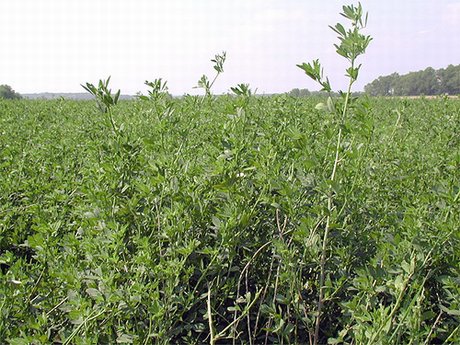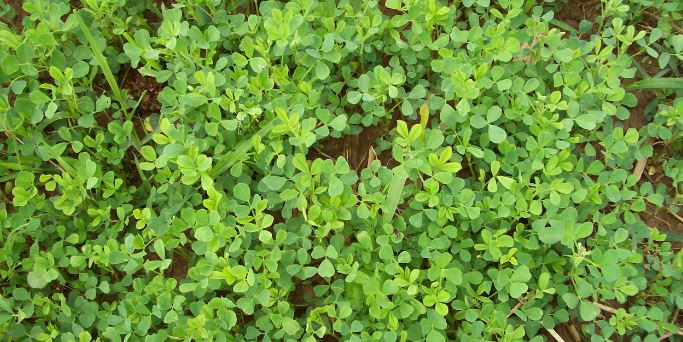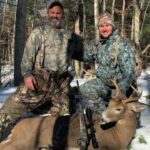Welcome to the world of alfalfa deer food plots! In this guide, we’ll dive into the nutritional benefits of alfalfa for deer, explore the secrets of planting and maintaining successful food plots, and uncover the economic considerations involved. Whether you’re a seasoned hunter or a landowner looking to enhance your property for wildlife, this comprehensive guide has got you covered.
Alfalfa as a Deer Food Source


Alfalfa is a highly nutritious forage crop that is an excellent food source for deer. It is high in protein, energy, and minerals, and it is also a good source of vitamins. Deer that have access to alfalfa will have improved health and antler growth.
Nutritional Value of Alfalfa
Alfalfa is a good source of the following nutrients:
- Protein: Alfalfa is a high-protein forage, with a crude protein content of 15-20%. This protein is essential for deer growth and antler development.
- Energy: Alfalfa is also a high-energy forage, with a total digestible nutrient (TDN) content of 55-65%. This energy is essential for deer to maintain their body weight and activity levels.
- Minerals: Alfalfa is a good source of minerals, including calcium, phosphorus, potassium, and magnesium. These minerals are essential for deer health and antler growth.
- Vitamins: Alfalfa is a good source of vitamins, including vitamins A, D, and E. These vitamins are essential for deer health and reproduction.
Benefits of Planting Alfalfa in Food Plots for Deer
Planting alfalfa in food plots can provide a number of benefits for deer, including:
- Improved health: Deer that have access to alfalfa will have improved health. This is because alfalfa is a good source of nutrients that are essential for deer health, including protein, energy, minerals, and vitamins.
- Increased antler growth: Deer that have access to alfalfa will have increased antler growth. This is because alfalfa is a good source of protein, which is essential for antler growth.
- Attracting deer: Alfalfa is a highly palatable forage that is attractive to deer. This makes it an excellent choice for food plots, as it will help to attract deer to the area.
Examples of How Alfalfa Can Improve Deer Health and Antler Growth
There are a number of examples of how alfalfa can improve deer health and antler growth. For example, a study conducted by the University of Georgia found that deer that had access to alfalfa had improved body weight and antler growth compared to deer that did not have access to alfalfa.
Another study conducted by the University of Missouri found that deer that had access to alfalfa had increased fawn survival rates compared to deer that did not have access to alfalfa.
Planting and Maintaining Alfalfa Food Plots


Establishing and maintaining productive alfalfa food plots requires careful attention to soil conditions, planting techniques, and management practices. By following these guidelines, hunters can provide a high-quality food source that will attract and hold deer throughout the year.
Soil Conditions and Preparation
Alfalfa thrives in well-drained soils with a pH between 6.5 and 7.5. Before planting, soil should be tested to determine its pH and nutrient levels. If the pH is too low, lime should be applied to raise it to the desired range.
Soil should also be amended with phosphorus and potassium as needed.
Planting Techniques
Alfalfa is typically planted in the spring or fall. The seed should be drilled into the soil at a depth of 1/4 to 1/2 inch. A seeding rate of 15 to 20 pounds per acre is recommended. After planting, the seedbed should be rolled or packed to ensure good seed-to-soil contact.
Mowing and Fertilization, Alfalfa deer food plot
Mowing is an essential part of alfalfa management. It helps to control weeds, promote new growth, and prevent the plants from becoming too tall and spindly. Alfalfa should be mowed at a height of 6 to 8 inches when it reaches a height of 12 to 15 inches.
Alfalfa deer food plots are a great way to attract deer to your hunting area. These plots are easy to establish and maintain, and they can provide a significant source of food for deer throughout the year. If you’re looking for a way to improve your deer hunting success, consider planting an alfalfa deer food plot.
You can learn more about 300 blackout rifle deer hunting by visiting our website. In addition to providing food for deer, alfalfa deer food plots can also help to improve the quality of your soil. Alfalfa is a nitrogen-fixing plant, which means that it can convert atmospheric nitrogen into a form that can be used by plants.
This can help to improve the fertility of your soil and make it more productive for other crops.
Fertilization is also important for maintaining healthy alfalfa stands. Alfalfa should be fertilized with nitrogen, phosphorus, and potassium according to soil test recommendations.
Pest and Disease Control
Alfalfa is susceptible to a number of pests and diseases, including aphids, leafhoppers, and root rot. These pests and diseases can be controlled through a variety of methods, including chemical applications, biological control, and cultural practices.
Site Selection and Management


Choosing the right location and managing your alfalfa food plot effectively are crucial for successful deer attraction and forage production. Here are key considerations and best practices to optimize your plot’s performance.
Soil Type, Drainage, and Sunlight Exposure
Alfalfa thrives in well-drained, fertile soils with a pH between 6.5 and 7.5. Avoid planting in poorly drained areas or soils with excessive acidity or alkalinity. Adequate sunlight is also essential, with at least six hours of direct sunlight per day.
Crop Rotation and Companion Planting
Crop rotation is essential for maintaining soil health and preventing disease buildup. Rotate alfalfa with other crops, such as corn or soybeans, to break disease cycles and improve soil fertility. Companion planting with grasses or legumes can also benefit alfalfa by suppressing weeds and improving soil structure.
Weed and Pest Control
Weeds and pests can significantly reduce alfalfa yield and quality. Regularly monitor your plot for weeds and control them promptly using herbicides or mechanical methods. Pests, such as aphids and alfalfa weevils, can also be problematic. Use integrated pest management techniques, including biological controls and chemical treatments when necessary, to minimize their impact.
Harvesting and Utilization
Alfalfa food plots can be harvested at various stages of maturity, depending on the intended use. The optimal timing and methods for harvesting are crucial to ensure high-quality forage with maximum nutritional value.
The primary methods for harvesting alfalfa include grazing, baling, and making hay. Each method has its own advantages and considerations.
Grazing
Grazing is a simple and cost-effective way to utilize alfalfa food plots. It allows livestock to graze directly on the alfalfa plants, providing them with fresh, nutritious forage.
To ensure sustainable grazing, it is important to manage grazing intensity and duration carefully. Overgrazing can damage alfalfa plants and reduce their productivity. Proper grazing practices include rotational grazing and providing adequate rest periods for the plants to recover.
Baling
Baling involves cutting and baling alfalfa hay for storage and later use. This method is suitable for larger food plots or when there is a need for long-term storage.
The timing of baling is critical to preserve the nutritional value of alfalfa. Baling should be done when the alfalfa plants reach the bud to early bloom stage. This ensures high protein and energy content in the hay.
Making Hay
Making hay is similar to baling, but involves drying the alfalfa before baling. This process requires suitable weather conditions to ensure proper drying and prevent spoilage.
Haymaking can be more time-consuming than baling, but it allows for greater control over the drying process and can result in higher-quality hay.
Storage and Preservation
Proper storage and preservation techniques are essential to maintain the nutritional value of harvested alfalfa.
Bales or hay should be stored in a dry, well-ventilated area to prevent moisture buildup and spoilage. Regular monitoring for mold or other signs of spoilage is important.
To maximize the preservation of alfalfa, consider using airtight storage containers or vacuum sealing to minimize exposure to oxygen and moisture.
Economic Considerations


The economic aspects of establishing and maintaining alfalfa food plots for deer hunting are crucial for both hunters and landowners to consider. The costs involved and the potential return on investment (ROI) play a significant role in decision-making.
Cost Analysis
The initial costs of establishing an alfalfa food plot include land preparation, seed purchase, planting, and fertilization. Land preparation involves clearing the area of vegetation, leveling the ground, and improving drainage. Seed costs vary depending on the variety of alfalfa chosen and the size of the plot.
Planting can be done by hand or with a seed drill, and fertilization is essential for optimal plant growth.
Maintenance Costs
Once the alfalfa food plot is established, ongoing maintenance costs include mowing, weed control, and fertilization. Mowing helps control weeds and promote new growth, while weed control prevents unwanted plants from competing with the alfalfa. Fertilization is necessary to replenish nutrients in the soil and ensure the health and productivity of the alfalfa stand.
Return on Investment
The ROI for alfalfa food plots can be substantial for deer hunters. By providing a high-quality food source for deer, hunters can increase the likelihood of successful hunts. The increased hunting success can lead to increased revenue for landowners through hunting leases or guided hunts.
If you’re looking for an easy-to-grow and nutritious deer food plot, alfalfa is a great option. It’s high in protein and minerals, and deer love it. If you’re in the Deer Park, Oregon area, check out the Deer Park Food Plots . They have a variety of food plot options, including alfalfa, and can help you choose the right one for your needs.
Alfalfa is a great way to attract and feed deer on your property.
Government Programs
In some areas, government programs or incentives may be available to support alfalfa food plot planting. These programs can provide financial assistance or technical support to landowners who establish food plots for wildlife management purposes.
Wrap-Up: Alfalfa Deer Food Plot
So, there you have it! Alfalfa deer food plots offer a wealth of benefits for both deer and hunters alike. By following the guidelines Artikeld in this guide, you can create a thriving food source that will attract and sustain deer on your property.
Remember, the key to success lies in proper planning, planting, and maintenance. With a little effort and dedication, you can establish a food plot that will provide years of enjoyment and hunting opportunities.
Essential Questionnaire
How long does it take for alfalfa to establish?
Alfalfa typically takes 3-4 years to fully establish and reach its maximum yield potential.
What is the best time to plant alfalfa?
The optimal time to plant alfalfa is in the fall or early spring, when soil temperatures are between 50-60°F.
How often should I mow my alfalfa food plot?
Mowing your alfalfa food plot 2-3 times per year will help control weeds and encourage new growth.
How much does it cost to establish an alfalfa food plot?
The cost of establishing an alfalfa food plot can vary depending on factors such as land preparation, seed costs, and labor. On average, it can range from $200 to $500 per acre.








